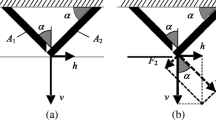Abstract
We studied the reliability of machine components with parameters that follow an arbitrary statistical distribution using the principle of maximum entropy (PME). We used PME to select the statistical distribution that best fits the available information. We also established a probability density function (PDF) and a failure probability model for the parameters of mechanical components using the concept of entropy and the PME. We obtained the first four moments of the state function for reliability analysis and design. Furthermore, we attained an estimate of the PDF with the fewest human bias factors using the PME. This function was used to calculate the reliability of the machine components, including a connecting rod, a vehicle half-shaft, a front axle, a rear axle housing, and a leaf spring, which have parameters that typically follow a non-normal distribution. Simulations were conducted for comparison. This study provides a design methodology for the reliability of mechanical components for practical engineering projects.
Similar content being viewed by others
References
Kapur K C, Lamberson L R. Reliability in Engineering Design. New York: John Wiley & Sons, 1977
Dhillon B S, Singh C. Engineering Reliability. New York: John Wiley & Sons, 1981
Henley E J, Kumamoto H. Reliability Engineering and Risk Assessment. Englewood Cliffs: Prentice-Hall Inc., 1981
O’Connor P D T. Practical Reliability Engineering. New York: John Wiley & Sons, 1984
Wasserman G S. Reliability Verification, Testing, and Analysis in Engineering Design. New York: Marcel Dekker, Inc., 2002
Ang A H S, Tang W H. Probability Concepts in Engineering Planning and Design. New York: John Wiley & Sons, 2006
Elsayed A E. Reliability Engineering. 2nd ed. New York: John Wiley & Sons, 2012
Klyatis L M. Accelerated Reliability and Durability Testing Technology. New York: John Wiley & Sons, 2012
Zhang Y. Reliability Design of Automobile Components. Beijing: Beijing Institute of Technology Press, 2000 (in Chinese)
Zhang Y. Introduction of Mechanical Reliability. Beijing: Science Press, 2012 (in Chinese)
Zhang Y. Reliability-based design for automobiles in China. Frontiers of Mechanical Engineering in China, 2008, 3(4): 369–376
Zhang Y. Connotation and development of mechanical reliabilitybased design. Chinese Journal of Mechanical Engineering, 2010, 46 (14): 167–188
Zhang Y. Review of theory and technology of mechanical reliability for dynamic and gradual systems. Journal of Mechanical Engineering, 2013, 49(20): 101–114 (in Chinese)
Zhang Y, Sun Z. The reliability syllabus of mechanical products. Journal of Mechanical Engineering, 2014, 50(14): 14–20 (in Chinese)
Siddall J N. Optimal Engineering Design: Principles and Application. New York: Marcel Dekker, 1982
Dai Y S, Xie M, Long Q, et al. Uncertainty analysis in software reliability modeling by Bayesian approach with maximum-entropy principle. IEEE Transactions on Software Engineering, 2007, 33 (11): 781–795
Sung Y H, Kwak B M. Reliability bound based on the maximum entropy principle with respect to the first truncated moment. Journal of Mechanical Science and Technology, 2010, 24(9): 1891–1900
Shi X, Teixeira A P, Zhang J, et al. Structural reliability analysis based on probabilistic response modelling using the maximum entropy method. Engineering Structures, 2014, 70: 106–116
Chatzis S P, Andreou A S. Maximum entropy discrimination Poisson regression for software reliability modeling. IEEE Transactions on Neural Networks and Learning Systems, 2015, 26(11): 2689–2701
Zhang Y, Liu Q. Reliability-based design of automobile components. Proceedings of the Institution of Mechanical Engineers. Part D, Journal of Automobile Engineering, 2002, 216(6): 455–471
Zhang Y, He X, Liu Q, et al. Reliability sensitivity of automobile components with arbitrary distribution parameters. Proceedings of the Institution of Mechanical Engineers. Part D, Journal of Automobile Engineering, 2005, 219(2): 165–182
Zhang Y. Reliability-based robust design optimization of vehicle components, Part I: Theory. Frontiers of Mechanical Engineering, 2015, 10(2): 138–144
Zhang Y. Reliability-based robust design optimization of vehicle components, Part II: Case studies. Frontiers of Mechanical Engineering, 2015, 10(2): 145–153
Acknowledgements
We would like to express our appreciation to the National Natural Science Foundation of China (Grant No. U1708254) for supporting this research.
Author information
Authors and Affiliations
Corresponding author
Rights and permissions
About this article
Cite this article
Zhang, Y. Principle of maximum entropy for reliability analysis in the design of machine components. Front. Mech. Eng. 14, 21–32 (2019). https://doi.org/10.1007/s11465-018-0512-z
Received:
Accepted:
Published:
Issue Date:
DOI: https://doi.org/10.1007/s11465-018-0512-z




